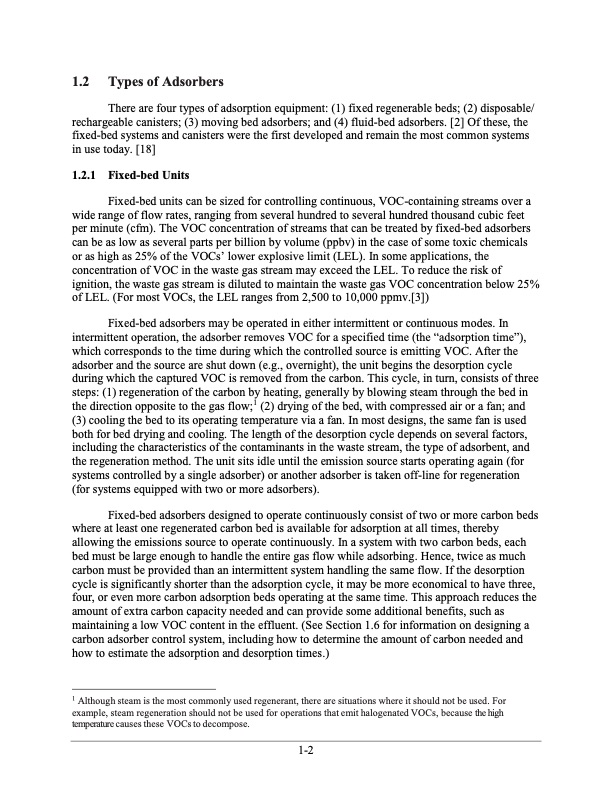
PDF Publication Title:
Text from PDF Page: 006
1.2 Types of Adsorbers There are four types of adsorption equipment: (1) fixed regenerable beds; (2) disposable/ rechargeable canisters; (3) moving bed adsorbers; and (4) fluid-bed adsorbers. [2] Of these, the fixed-bed systems and canisters were the first developed and remain the most common systems in use today. [18] 1.2.1 Fixed-bed Units Fixed-bed units can be sized for controlling continuous, VOC-containing streams over a wide range of flow rates, ranging from several hundred to several hundred thousand cubic feet per minute (cfm). The VOC concentration of streams that can be treated by fixed-bed adsorbers can be as low as several parts per billion by volume (ppbv) in the case of some toxic chemicals or as high as 25% of the VOCs’ lower explosive limit (LEL). In some applications, the concentration of VOC in the waste gas stream may exceed the LEL. To reduce the risk of ignition, the waste gas stream is diluted to maintain the waste gas VOC concentration below 25% of LEL. (For most VOCs, the LEL ranges from 2,500 to 10,000 ppmv.[3]) Fixed-bed adsorbers may be operated in either intermittent or continuous modes. In intermittent operation, the adsorber removes VOC for a specified time (the “adsorption time”), which corresponds to the time during which the controlled source is emitting VOC. After the adsorber and the source are shut down (e.g., overnight), the unit begins the desorption cycle during which the captured VOC is removed from the carbon. This cycle, in turn, consists of three steps: (1) regeneration of the carbon by heating, generally by blowing steam through the bed in the direction opposite to the gas flow;1 (2) drying of the bed, with compressed air or a fan; and (3) cooling the bed to its operating temperature via a fan. In most designs, the same fan is used both for bed drying and cooling. The length of the desorption cycle depends on several factors, including the characteristics of the contaminants in the waste stream, the type of adsorbent, and the regeneration method. The unit sits idle until the emission source starts operating again (for systems controlled by a single adsorber) or another adsorber is taken off-line for regeneration (for systems equipped with two or more adsorbers). Fixed-bed adsorbers designed to operate continuously consist of two or more carbon beds where at least one regenerated carbon bed is available for adsorption at all times, thereby allowing the emissions source to operate continuously. In a system with two carbon beds, each bed must be large enough to handle the entire gas flow while adsorbing. Hence, twice as much carbon must be provided than an intermittent system handling the same flow. If the desorption cycle is significantly shorter than the adsorption cycle, it may be more economical to have three, four, or even more carbon adsorption beds operating at the same time. This approach reduces the amount of extra carbon capacity needed and can provide some additional benefits, such as maintaining a low VOC content in the effluent. (See Section 1.6 for information on designing a carbon adsorber control system, including how to determine the amount of carbon needed and how to estimate the adsorption and desorption times.) 1 Although steam is the most commonly used regenerant, there are situations where it should not be used. For example, steam regeneration should not be used for operations that emit halogenated VOCs, because the high temperature causes these VOCs to decompose. 1-2PDF Image | Carbon Adsorbers

PDF Search Title:
Carbon AdsorbersOriginal File Name Searched:
final_carbonadsorberschapter_7thedition.pdfDIY PDF Search: Google It | Yahoo | Bing
CO2 Organic Rankine Cycle Experimenter Platform The supercritical CO2 phase change system is both a heat pump and organic rankine cycle which can be used for those purposes and as a supercritical extractor for advanced subcritical and supercritical extraction technology. Uses include producing nanoparticles, precious metal CO2 extraction, lithium battery recycling, and other applications... More Info
Heat Pumps CO2 ORC Heat Pump System Platform More Info
| CONTACT TEL: 608-238-6001 Email: greg@infinityturbine.com | RSS | AMP |